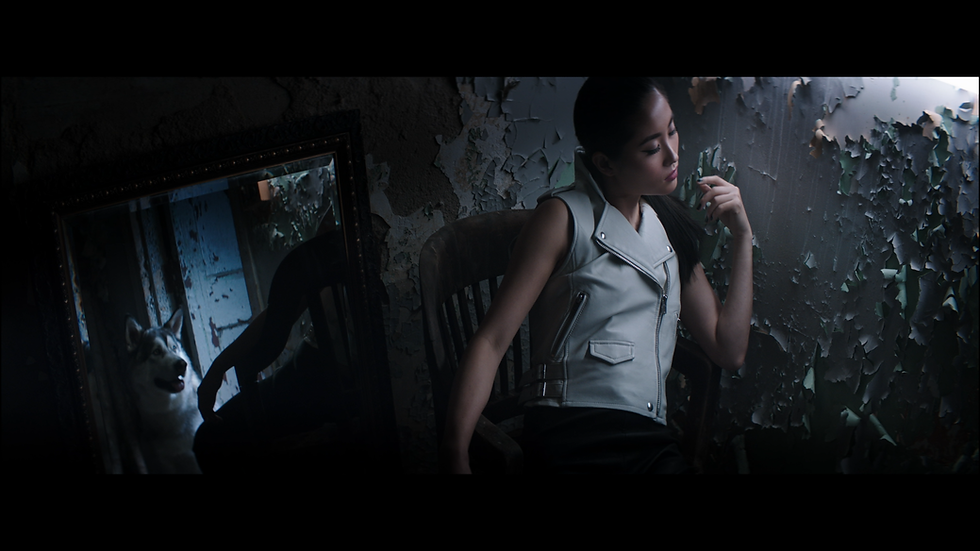FEATURED: Q&A With Creative Talent Stephanie Bollag
- Jordan P. Kelley
- Jul 18, 2017
- 6 min read
Stephanie Bollag is a woman with a vision. Bollag, a Swiss film student at the Tisch Graduate School, is a storyteller and fashion filmmaker whose work is both dark and tender, provocative and sensitive. In her last semester at NYU, after directing several narrative shorts, she discovered her niche: visually and viscerally evocative stories at the intersection of fashion and film told through the female gaze.
Her fashion film A Tale of Endurance: Celebration of the Imperfect, which she wrote, directed, produced and edited on spec for the French fashion brand IRO Paris is a celebration of color, race and women. It is meant to send an empowering and disruptive message about pre existing gender norms and racial stereotypes.
Brand Storytelling connected with Bollag to discuss her draw as a creative to making branded films, the value of having brands partner with creatives, and the importance of connecting with brands to tell authentic stories.
You call yourself a “fashion filmmaker.” What does that mean to you? How did that come to be your niche?
First and foremost, I am a filmmaker and storyteller. That said I feel at home with fashion. I grew up embedded in the business. My father was one of the people to make ESPRIT big in the 80s. The funny thing is that I always rejected the idea of following in his footsteps. Cinema is what fascinated me, and I could not envision a career in fashion.
Over the past two decades and especially during my graduate film studies at NYU Tisch, I refined and defined my aesthetic and sensibility. It also became evident that my ideas generally were too grand and too dreamy for the naturalist, indie filmmaking approach film school teaches. Which is how I discovered my niche; visually and viscerally evocative stories at the intersection of film and fashion told through the female gaze.
To me being a fashion filmmaker means that I can express stories and emotions visually without the expectation of a coherent storyline. Fashion films allow me to follow my gut and engage audiences through visuals. A strong, beautiful or disturbing photograph or painting can evoke all sorts of reactions. You can feel pain or pleasure by merely looking at an image. It is that visceral quality I strive to achieve in my work. As a classically trained painter turned filmmaker I found that fashion films allow me to do so.
How did you settle on this project? At what point did you connect with IRO to work on this project?
I wanted to create something edgy, dark and powerful. Early on the French fashion label IRO came to mind. A few years back I was introduced to the founders/designers of IRO, while doing the fashion buying for the IRO store in Zurich. I since followed the brand’s progress and kept in touch with the designers. I had just barely conceptualized the idea and pitch for the film, when I reached out with a questionnaire about the philosophy and mission of their label. The designers were familiar with my previous work and open to the idea of a fashion film for IRO.
“A Tale of Endurance: Celebration of the Imperfect” is a weighty title for a fashion film in which all of the communication is done with physicality and the face. Where did the concept come from? Where did the brand stand on this concept? Why offer to do something like this on spec? What do you seek to gain in creating work like this for yourself?
All my narrative films to date are centered on female characters trapped or confined by some inner or outer force, which they try to break free from. Life for them is “a tale of endurance” no matter the outcome. Enduring makes them stronger and more resilient. 18 months ago my father was diagnosed with terminal cancer. In situations of life and death everything becomes heightened and so did my artistic vision. I had all these emotions I could not put into words. This influenced my decision to make a film in which the images, sounds and music (not words) would carry the story.
Another source of inspiration for the concept was the interchangeability of IRO’s clothes between the sexes, which sparked the film’s central themes of androgyny and sexual identity. Fitting the models and actors at the IRO showroom in NYC, my stylist frequently assigned an article from the men’s collection to a female model/actor and vice versa.
Like most artists I felt an outsider growing up in Switzerland. Living in New York I feel at home. The norm does not interest me. A Tale of Endurance is thus also a tribute to the hodgepodge that is New York. Diversity yields emotional and visual texture. The models and actors I cast are of every color, ethnicity, gender, shape and size. The film’s superhero is a woman disrupting the status quo. As a result the film is multilayered and hopefully prompts discussions that extend past the surface.
I offered to make this film on spec for IRO for a few reasons. To me IRO’s clothes implied an untold story. Their unconventional use of hard and soft materials is reminiscent of my own visual language and sensibility. I imagined the IRO woman as a heroine in one of my films. But most of all, I saw a missed opportunity for a strong brand to market its product. Going into it I knew there was a risk of IRO rejecting the film, but I had nothing to lose. “Worst case” I would end up with a fashion film that embodies my aesthetic and vision and could be used to present myself to future fashion brands and collaborators. Whereas IRO liked my original concept and mood boards, and gave us access to their Pre- and SS17 collections, they finally found the film too risky and arty. Ultimately the film was not commercial enough for them.
As a storyteller, how do you feel about brands’ increased interest in moving toward artful storytelling rather than simply continuing to produce traditional interruptive advertisements?
It means my livelihood, so I fully support the trend. But jokes aside, I definitely agree that we are slowly moving away from advertising in the traditional sense towards more narrative marketing campaigns. In a world in which information is overflowing, showing off a brand’s USP (Unique Selling Proposition) does no longer suffice. Rather than a rational explanation of why their product is better, cooler, etc., brands need to appeal to audiences’ subjective experiences. The intangible is what determines the success of that tangible thing they are trying to sell. And what better way to market a product or service than by telling a compelling story that attaches meaning and emotion to it. Brands are only just starting to understand the value that storytelling and filmmaking bring to the table.
To me the creation of fashion films and branded content is not merely about making something artsy that is cool looking. Real storytelling means connecting the audience to the brand’s core value system. Today’s audiences can’t be emotionally coerced into brand loyalty. They are smart and demand a continuous relationship that needs to be groomed. Brands need to understand that the storytelling approach to advertising is a long game and a lasting effort to produce meaningful and appealing content that showcases the brand favorably while remaining emotionally connected and relevant to its target audience. This can only be achieved over time. One film isn’t enough. But if used correctly the tool of storytelling will continue to give.
What advice would you give to up-and-coming creatives looking to foster great working relationships with brands?
It is a fine balance between keeping up to date with what is happening in the ever-changing marketplace and fostering your aesthetic and stories on your own terms. It is a constant juggle between listening to others and following your gut. Having a strong portfolio, website and/or a film that represents your sense of story and style to a potential client is key. I would advise any aspiring creative to experiment a bunch before putting their professional reputation on the line. The rules of ‘fake it till you make it’ don’t quite apply to filmmaking. There is a lot of knowledge, life experience and technical skills involved in the creation of a film. I am not saying film school is a must, but it definitely gave me the liberty to experiment and ultimately find my niche. Nothing beats having a deep understanding of the craft and developing your own voice through trial and error. Of course that requires resilience and patience. In terms of pitching to clients, I would always advise to meet with them face to face. So much of what I do is based on personal interaction and chemistry. Treat them as your collaborators.
--
You can watch Stephanie’s fashion film HERE
Credits:
Client
IRO Paris
Director/Writer/Producer/Editor
Stephanie Bollag
Starring
Melissa Weisz
Yansen Abreu
Simone Awor
Aloba Ayinde
Cassy Cammarano
Emma Chaves
Simone Di Donna
Fraser Edwards
Arianna Levesque
Andrea Levesque
Athena Levesque
Alexa Marie Santy
Sheena Sakai
Charity Woods
Wolf/dog - Balto
Rabbit
Director of Photography
Lasse Ulvedal Tolbøll.
Stylist
Amanda Bollag
Producer
Kate Stahl
Composer
Victoria de la Vega
Sound Design
Bumi Hidaka
Editor
Alan Wu
Colorist
Dave Francis
Production Design
Erin Blake
Make-Up Artist
Pamela Fuentes
Hair Stylist
Bella Bonder
Assistant Director
Molly Gandour
Assistant Camera
Zamarin Wahdat
Mamadou Dia
Gaffer
Rhys Jones
Best Boy
Anthony Saxe
Sound Mixer
Artur Szerejko
Set Photography
Tess Mayer
Driver
Eric Emma
Animal Handler
Gloria Winship
-- Watch for weekly news updates from Brand Storytelling in your inbox by subscribing, and share this with other storytellers in your network. Of course, if you’d like to contribute to the story, We'd love to hear from you. Email us!




























